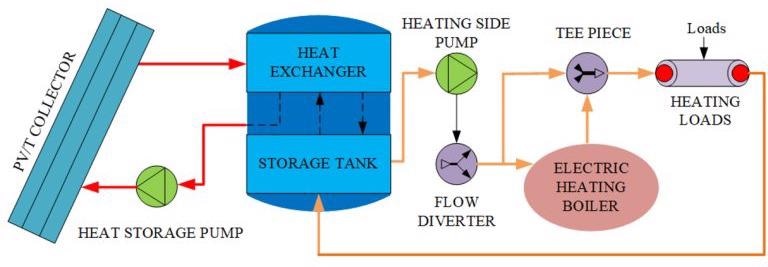Adding an organic matter power source to a solar energy unit has the potential to help the environment and provide 100% heating for a single-story home during the coldest months of the year.
 Flow diagram of solar-biomass hybrid system. Image Credit: Gaoyang Hou and Lei Xu/ Northwest A&F University.
Flow diagram of solar-biomass hybrid system. Image Credit: Gaoyang Hou and Lei Xu/ Northwest A&F University.
The system could also produce electricity in excess that could be sold back to the grid in the warmer months.
In the Journal of Renewable and Sustainable Energy, reported by AIP Publishing, scientists in China and the United States describe a computer simulation model fulfilling the difficulty of solar power’s inherent intermittency.
This is done via the addition of biomass as another renewable energy source to progress a dependable and cost-effective heating solution while decreasing carbon dioxide emissions.
We demonstrate how this hybrid system provides a cleaner, more energy-efficient heating solution than fossil fuel in single-family homes. The system would be convenient in rural communities, where farms have large amounts of biomass in the form of agricultural waste that can be combined with solar power to close the urban-rural electricity gap and help the environment in the process.
Gaoyang Hou, Study Co-Author, Northwest A&F University
The suggested solar-biomass hybrid system has been relying on distributed multi-generation technology that incorporated biomass power sources and photovoltaic-thermal (PV/T).
Production of biomass is made from renewable organic matter, like nutshells, corn husks, wood pulp, and food and animal waste. A PV/T system, made of thermal collectors and PV panels, is a developing technology that transforms solar energy into both heat and electricity with greater energy conversion efficiency.
Studies performed on developing decentralized hybrid systems have concentrated on commercial greenhouse farms and neighborhoods. The scientists assessed their system depending on the heating requirements of a single-story cottage from November to March in northwest China. Here, temperatures in winter could dip below minus 20 °C (−4 °F).
Amongst the total energy input, the PV/T collector produced 52% of the electrical energy and seized 8% of the thermal energy that was available. The biomass produced the remaining 40% of the electricity required to heat the house.
For the entire heating season, solar power predominates the energy supply side, with the biomass energy generation kicking in when needed to make up the energy deficit.
Lei Xu, Study Co-Author, Northwest A&F University
The researchers made their simulation model in TRNSYS (brief for transient system simulation tool), a modular thermal system software utilized to evaluate the performance of electrical and thermal renewable energy systems.
Their hybrid system simulation was comprised of flow diverters, PV/T collector, heat pump, storage tank with a backup electric boiler, immersed coiled-tube heat exchanger, and other components.
Scientists have come up with a solar-biomass system model to fulfill the heating and cooling demands of a small commercial building. Also, if successful, they have also planned to develop a prototype for experimental testing.
Journal Reference:
Xu, L., et al. (2022) Modeling and assessment of a novel solar-biomass based distributed multi-generation system. Journal of Renewable and Sustainable Energy. doi.org/10.1063/5.0085305.